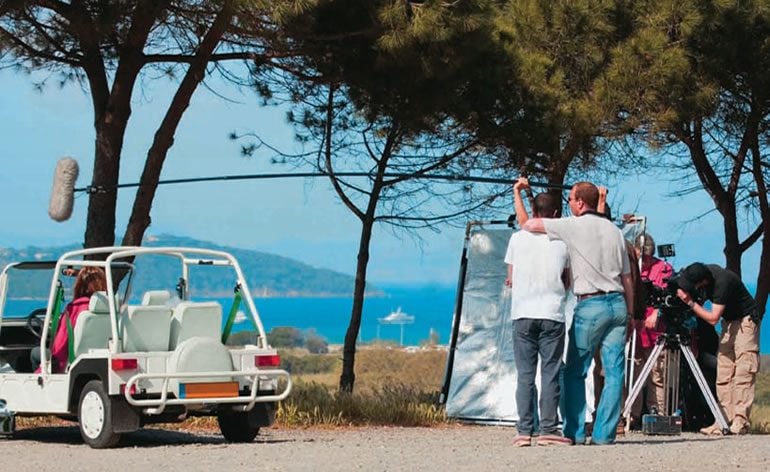Reference: StudentFilmmakers Magazine, May 2007. Protecting Yourself and Your Gear in Difficult Environmental Conditions: Rainy, Windy, and Dusty Locations by Kevin Zanitconstantly. Pages 50 & 51.
In the business of production, we often find ourselves trying to accomplish our work in conditions that would make most people just want to ‘stay indoors.’ Not only do we have to sometimes work in difficult environmental conditions, we also need to protect ourselves and our equipment. This advice is in no means completely comprehensive; think of it as some basic guidelines for working in rainy, windy, or dusty locations. Some of the recommended items would not be on set unless these conditions are expected in advance, but some items can be carried as simple expendables.
Working in the rain presents many challenges. Some of the challenges involve keeping the set safe (minimizing risks of electric shock), and keeping camera equipment safe. You may want to have on hand a circular rain deflector (to keep rain drops from showing up on screen), trash bags and plastic baggies, a splash bag, or even a water housing (depending on the amount of rain), large plastic trash bags to cover carts, and even better to ask production to have extra pop-up tents to cover your staging area. Also, remember that tape may have problems sticking to various parts of the camera in cold or wet conditions. If it is especially cold out, be careful to not store lenses in a warm location and then immediately bring them into the cold set, because they will fog.
For the electric department, you will need to procure enough apple boxes to elevate all your connectors and distribution / lunch boxes. Even better than apple boxes are “swamp boxes” that have small legs that don’t make water collect as much as an apple box does. You will need to make small tents out of a plastic / metal mesh called Celoflex on the bale of the lights to protect them from the rain. You will need to constantly check the Celoflex because the plastic melts over time, rendering the material useless in stopping water. Use visqueen plastic to wrap around electrical connections. Use heat shield, a very weak color gel, or scrims to help shield the hot lens from any water drops. If water hits the hot lens of a light it can crack or explode due to “thermal shock”. You also need to have the proper type of ground fault circuit interrupters (GFCIs or GFIs). It is critical that you have a “Type A” GFCI that is rated for the voltages you are working with. Consult with the rental house on this information.
The grip department may be asked for extra 4×4 frames of gel to make small rain covers or may be asked for frames of griff to cover larger areas. The grip department does not have too much to worry about protecting from the rain.
You will also need to protect yourself from the rain. Have some extra shoes and socks prepared in case they get soaked, have at least one or two light jackets that are waterproof (if you have two, you can double up and have layers to take off if you get hot), a good hat to offer some cover from the rain can be handy, and a towel is nice for when you are done.
Working in windy conditions can present its own set of challenges. If the wind is man-made by the special effects department, it is safe to expect a lot of it! For the camera department the issue is not really the wind in and of itself, but what debris the wind blows. If it also dusty, an optical flat in front of the lens is not a bad idea, but mainly it is just important to Zanitconstantly check the lens for dirt and dust. Also, taping some areas of the camera that dust could work itself into with the strong wind is wise. Being extra diligent with gate checks is a good idea.
For the electric department, heat shield or a single scrim is important to protect the hot lens from the cold wind in order to prevent thermal shock. You also may need to use small grip clips instead of C47s to hold gel to the barn doors as gel can be easily blown off in strong winds.
For the grip department, you may need lots of extra sandbags to secure everything in the wind. Also, be sure to have enough rope for tying guy lines to any large frames of diffusion, etc.
For yourself, have eye protection, as dust being blown at a high rate of speed is never fun when it hits your eyes. If large wind machines are in use, ear protection is wise as they can often be very loud. Having a jacket and hat with chin strap (to keep it from blowing off your head) is not a bad idea either.
When working in the dirt, many of the same precautions are used as when working in wind. For the camera department, it is important to be on top of gate checks and insuring that magazines and changing bags / tents stay clean.
For the electric department, try to keep connectors from dragging in the dirt so they don’t get “crunchy” and hard to connect. It is a good idea to place a small band of tape around connectors to seal them closed so dirt will not get in.
Also, “desert wrap” your cables – connecting the male and female ends of a cable into each other so that dirt does not get inside when the cables are not being used.
The grip department does not have much to worry about other than trying to maintain a certain amount of cleanliness so that risers of stands and threads of clamps, etc. don’t get stuck together.
This list is far from complete, but these tips should help you be prepared for some of the worst conditions we face. When in doubt about the safety of people, the best bet is to just say no to the people trying to get you to work in these conditions. If it is known ahead of time what the conditions will be like, research what you need to do in order to protect your gear and people.
Kevin Zanit is a cinematographer based in California. His experience is mostly in music videos and does narrative work as well. His filmography includes Room Service (2006), These Days (2006), Inner Prison (2005), and Passing Moments (2003).





